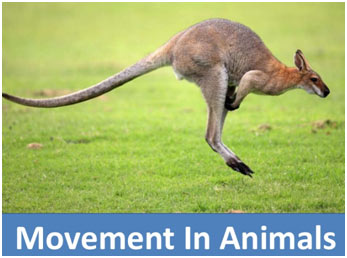Locomotion in Different Organisms
Animal locomotion, in ethology, is any of a variety of methods that animals utilize to move from one location to another.
Some modes of locomotion are self-propelled, e.g., running, swimming, leaping, flying, hopping, soaring, and gliding.
A few of the representative animals with their mobilities are following.
- 1) Locomotion in Euglena
- 2) Locomotion in Paramecium
- 3) Locomotion in Amoeba
- 4) Locomotion in Jellyfish
- 5) Locomotion in Earthworm
- 6) Locomotion in Cockroach
- 7) Locomotion in Snail
- 8) Locomotion in Starfish
- 9) MCQs on Locomotion in Different Organisms
- 10) Frequently Asked Questions (FAQs) – Locomotion in Different Organisms
- 11) Summary – Locomotion in Different Organisms
Locomotion in Euglena
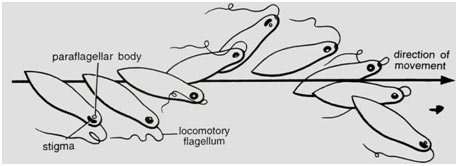
Euglena moves with the help of flagellum. As the flagellum is whipped backward, the organism moves forward. Nevertheless, when the flagellum moves forward Euglena does stagnate backward. Locomotoryflagellum is at the anterior end of the body and pulls the organism forward. Waves of activity are produced by the flagellum itself, and they pass in a spiral style from its base to its tip.
They increase amplitude and velocity. The activity note of the flagellum triggers the body of Euglena to turn forward about its axis. Euglena has the ability to change its direction by the active contractile myonemes which run along the length of its body. When they contract the shape of the body as well as its direction changes. First, the body becomes short and wider at the anterior end than in the center and later on at the posterior end. This particular movement is called Euglenoid motion.
Locomotion in Paramecium
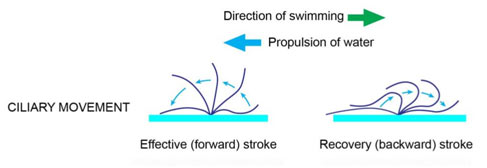
Paramecium moves with the help of cilia. This is called the ciliary movement. All the cilia do not move simultaneously, a lot of cilia move in a progressive wave-like way at a time. The wave starts at the anterior end and advances backward. Cilia are short, fine thread-like extensions of the cell membrane. The length of cilia ranges from numerous microns to lots of hundred microns and the size varies from 0.1 to 0.5. µ.
A cilium consists of nine peripheral double fibrils, giving the appearance of an 8-shaped figure and two central smaller fibrils. All these fibrils run longitudinally through the cilium. These are covered with the extensions of the membrane.
The precise system of movement of cilia is not known. Nevertheless in 1955 Bradford recommended that movement of cilia is because of the simultaneous contraction or sliding of double fibrils in 2 groups one after the other.
- Five out of 9 (5/9) double fibrils contract or slide at the same time with the result that cilium bend or reduce. It is called an effective stroke.
- The 4 out of nine (4/9) double fibrils contract and cilium ends up being, straight. It is called a recovery stroke.
As a result of bending and recovery strokes, the Paramecium swims against water the energy for the movement of cilia is provided from the ATP. The enzyme present in the cilia breaks up ATP to release energy.
The action of the cilia is coordinated and all the cilia beat together in a series to move the animal in one direction.
Locomotion in Amoeba
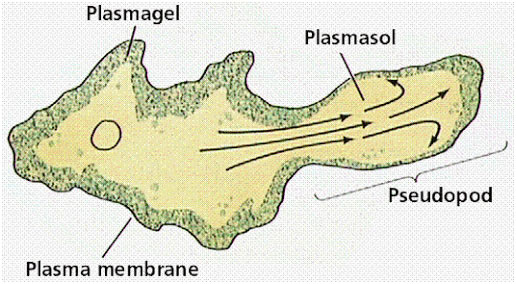
In Amoeba movement occurs by means of pseudopodia. The pseudopodia are finger-like projections in the direction of flow of the cytoplasm consequently, the body moves in that direction. The specific system of formation of pseudopodia is still debatable.
Locomotion in Jellyfish
Jellyfish has an umbrella-like body called bell. Firstly, water enters in the bell then the bell contracts, the water is propelled like a jet and the animal moves forward. This motion is called jet propulsion.
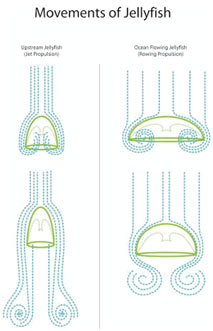
Locomotion in Earthworm
Earthworm shows accordion-like movement, in which setae and muscles both are included. First of all, earthworm becomes long and thin. The setae present on the lower side of the anterior end come out, anchor, and hold this end firmly.
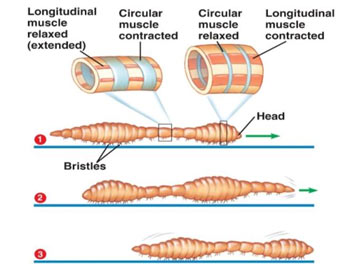
The longitudinal muscles now contract and circular muscles relax and the body shortens thus pulling this portion forward. Then the setae of the posterior end come out and fix the animal on the ground. Now circular muscles contract, longitudinal muscles relax and the body ends up being thin and long. In this way, the earthworm relocates from one place to the other.
Locomotion in Cockroach
The mode of mobility in cockroaches is quick walking but it also requires light by its wings. In walking, the legs are used on one side, the foreleg pulls the body forward and the hind leg pushes it in the same direction. The middle leg of the opposite side functions as a prop.
In the meantime, the remaining three legs start to move together and the process is repeated. Out of the two sets, the posterior set of wings brings about the flight. These beat in the air in such a way that they support the body weight and drive it through the air.
Locomotion in Snail
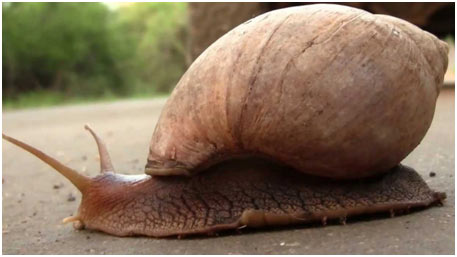
Snails and mussels are mollusks, which crawl or move extremely gradually by “foot”.
Locomotion in Starfish
Starfish moves with the help of tube feet. The tube feet exist on both sides of the radial canal that extends up to the pointer of the arm. The tube feet extend when water is pumped into them, then they fix themselves by suction cup to some object. Later on, they become shorten and pull the body in this direction. In this way, the starfish moves in any direction. Arms of the starfish also help in swimming.
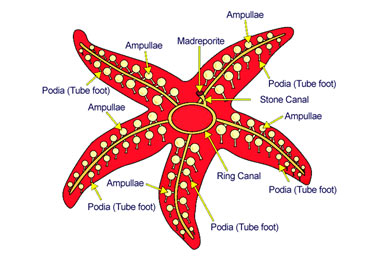
MCQs on Locomotion in Different Organisms
- What is the primary mode of locomotion in Euglena?
- A) Pseudopodia
- B) Cilia
- C) Flagellum
- D) Jet propulsion
- Answer: C
- How does Euglena change its direction during movement?
- A) Contractile myonemes
- B) Pseudopodia extension
- C) Circular muscles
- D) Setae anchoring
- Answer: A
- What is the locomotory structure in Paramecium?
- A) Pseudopodia
- B) Flagellum
- C) Cilia
- D) Tentacles
- Answer: C
- What is the effective stroke in the ciliary movement of Paramecium?
- A) Bending
- B) Recovery
- C) Contraction
- D) Sliding
- Answer: A
- How does Amoeba primarily move?
- A) Flagellum
- B) Jet propulsion
- C) Cilia
- D) Pseudopodia
- Answer: D
- What is the mode of locomotion in Jellyfish?
- A) Pseudopodia
- B) Jet propulsion
- C) Cilia
- D) Flagellum
- Answer: B
- Which movement is characteristic of Earthworm locomotion?
- A) Jet propulsion
- B) Accordion-like movement
- C) Pseudopodia extension
- D) Flagellar movement
- Answer: B
- How does a cockroach primarily move?
- A) Pseudopodia
- B) Jet propulsion
- C) Quick walking
- D) Setae anchoring
- Answer: C
- What is the mode of locomotion in Snail?
- A) Jet propulsion
- B) Pseudopodia
- C) Crawling on foot
- D) Flagellar movement
- Answer: C
- How does Starfish move?
- A) Pseudopodia extension
- B) Jet propulsion
- C) Tube feet
- D) Flagellum
- Answer: C
- Which organism exhibits movement by a whip-like structure called a flagellum?
- A) Amoeba
- B) Euglena
- C) Paramecium
- D) Jellyfish
- Answer: B
- What is the primary locomotory structure in Paramecium?
- A) Cilia
- B) Flagellum
- C) Pseudopodia
- D) Tentacles
- Answer: A
- How does Amoeba move, and what structures are involved?
- A) Jet propulsion, cilia
- B) Pseudopodia, flagellum
- C) Pseudopodia, cilia
- D) Crawling on foot, tube feet
- Answer: B
- What is the characteristic movement in Earthworm locomotion?
- A) Quick walking
- B) Accordion-like movement
- C) Crawling on foot
- D) Jet propulsion
- Answer: B
- In the locomotion of a cockroach, what propels the body forward?
- A) Cilia
- B) Setae
- C) Wings
- D) Pseudopodia
- Answer: B
- What is the primary mode of movement in Snail?
- A) Quick walking
- B) Crawling on foot
- C) Jet propulsion
- D) Flying
- Answer: B
- Which organism exhibits movement by contracting its circular and longitudinal muscles alternately?
- A) Paramecium
- B) Amoeba
- C) Earthworm
- D) Cockroach
- Answer: C
- What is the primary mode of locomotion in Starfish?
- A) Crawling on foot
- B) Jet propulsion
- C) Tube feet
- D) Pseudopodia
- Answer: C
- How does Euglena change its direction during movement?
- A) Pseudopodia extension
- B) Setae anchoring
- C) Circular muscle contraction
- D) Contractile myonemes
- Answer: D
- Which organism moves with umbrella-like bell contraction and jet propulsion?
- A) Amoeba
- B) Euglena
- C) Jellyfish
- D) Paramecium
- Answer: C
- What is the primary mode of movement in Jellyfish?
- A) Crawling on foot
- B) Flying
- C) Jet propulsion
- D) Quick walking
- Answer: C
- In what manner does Earthworm utilize its setae for locomotion?
- A) Anchoring and holding
- B) Contracting and sliding
- C) Extending for crawling
- D) Quick walking
- Answer: A
- How does Snail primarily move, and what is its locomotory structure?
- A) Crawling on foot, tentacles
- B) Flying, wings
- C) Jet propulsion, flagellum
- D) Quick walking, cilia
- Answer: A
Frequently Asked Questions (FAQs) – Locomotion in Different Organisms
- What is animal locomotion in ethology?
- Animal locomotion, in ethology, refers to any of a variety of methods that animals use to move from one location to another.
- What are some self-propelled modes of locomotion mentioned in the tutorial?
- Running, swimming, leaping, flying, hopping, soaring, and gliding are some self-propelled modes of locomotion.
- How does Euglena move, and what is the role of the flagellum?
- Euglena moves with the help of a flagellum. The flagellum, when whipped backward, propels the organism forward. It triggers the body to turn forward, and Euglena can change its direction using active contractile myonemes.
- What is the term for the specific movement of Euglena, and how is it achieved?
- The specific movement of Euglena is called Euglenoid motion. It is achieved by the contraction of active contractile myonemes along the length of its body.
- How does Paramecium move, and what is ciliary movement?
- Paramecium moves with the help of cilia, known as ciliary movement. Cilia move in a wave-like manner, starting at the anterior end and progressing backward.
- What is the effective stroke and recovery stroke in ciliary movement?
- The effective stroke involves contraction or sliding of five out of nine double fibrils, causing the cilium to bend. The recovery stroke occurs when four out of nine double fibrils contract, straightening the cilium.
- How does Amoeba move, and what structures are involved in its locomotion?
- Amoeba moves by forming pseudopodia, which are finger-like projections in the direction of cytoplasm flow.
- Describe the locomotion of Jellyfish.
- Jellyfish has an umbrella-like body called a bell. Water enters the bell, and when it contracts, the water is propelled like a jet, allowing the animal to move forward. This motion is known as jet propulsion.
- Explain the accordion-like movement in Earthworm locomotion.
- Earthworm exhibits accordion-like movement involving the coordinated action of setae and muscles. The body becomes long and thin, and the setae anchor and hold the anterior end. Contraction of longitudinal muscles and relaxation of circular muscles pull the body forward.
- How does Cockroach primarily move, and what role do wings play?
- Cockroach primarily moves by quick walking, and wings are used for flight. During walking, the foreleg pulls the body forward, and the hind leg pushes it in the same direction. The posterior set of wings facilitates flight.
- What is the primary mode of locomotion in Snail?
- Snails and mussels, being mollusks, move extremely slowly by crawling on a “foot.”
- How does Starfish move, and what is the role of tube feet?
- Starfish moves with the help of tube feet. Water is pumped into the tube feet, which then attach to an object. The tube feet shorten, pulling the body in that direction. The arms of the starfish also contribute to swimming.
Summary – Locomotion in Different Organisms
The tutorial delves into the fascinating world of animal locomotion, exploring various organisms and their distinctive methods of movement.
- Introduction:
- Animal locomotion encompasses diverse methods, both self-propelled and propelled by external forces, such as running, swimming, leaping, flying, hopping, soaring, and gliding.
- Euglena:
- Euglena utilizes a flagellum for movement. The flagellum’s backward whip propels the organism forward. The Euglenoid motion, facilitated by contractile myonemes, allows directional changes.
- Paramecium:
- Paramecium employs ciliary movement, with coordinated beats of cilia in a wave-like fashion. The effective and recovery strokes, driven by ATP energy, enable the organism to swim against water currents.
- Amoeba:
- Amoeba showcases movement through pseudopodia, finger-like projections directing cytoplasm flow. The specific mechanism of pseudopodia formation remains debatable.
- Jellyfish:
- Jellyfish achieves locomotion through jet propulsion. Water entering the bell is propelled out, moving the animal forward.
- Earthworm:
- Earthworm’s accordion-like movement involves setae and muscle coordination. Longitudinal muscle contraction and circular muscle relaxation allow the body to shorten and pull forward.
- Cockroach:
- Cockroach primarily walks swiftly, using its wings for flight. The legs on one side, foreleg and hind leg, coordinate for movement, while the posterior set of wings facilitates flight.
- Snail:
- Snails and mussels exhibit slow movement using a “foot” for crawling.
- Starfish:
- Starfish utilizes tube feet for movement. Water pumped into the feet allows attachment, followed by shortening to pull the body in any direction. Arms of the starfish contribute to swimming.
The tutorial provides a comprehensive overview of locomotion strategies in a diverse array of organisms, highlighting the marvels of adaptation and survival in the animal kingdom.

